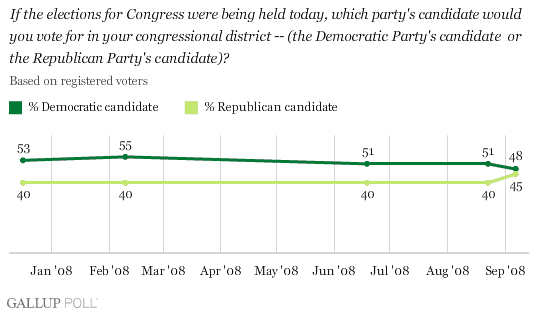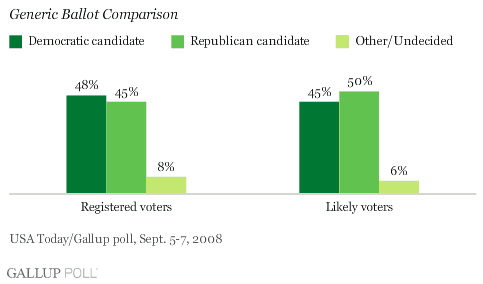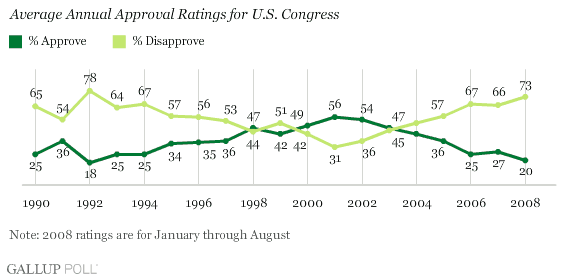PRINCETON, NJ -- A potential shift in fortunes for the Republicans in Congress is seen in the latest USA Today/Gallup survey, with the Democrats now leading the Republicans by just 3 percentage points, 48% to 45%, in voters' "generic ballot" preferences for Congress. This is down from consistent double-digit Democratic leads seen on this measure over the past year.

As is true for the current structure of voting preferences for president, Democratic voters are nearly uniform in their support for the Democratic candidate in their congressional districts (92%), Republican voters are nearly uniform in their support for the Republican candidate (94%), and independents are closely split, with 44% backing the Democrat and 40% the Republican.
The new results come from a Sept. 5-7 survey conducted immediately after the Republican National Convention and mirror the resulting enhanced position of the Republican Party seen in several other indicators. These range from John McCain's improved standing against Barack Obama in the presidential race to improved favorability ratings of the Republicans, to Republican gains in party identification. The sustainability of all of these findings is an open question that polling will answer over the next few weeks.
The positive impact of the GOP convention on polling indicators of Republican strength is further seen in the operation of Gallup's "likely voter" model in this survey. Republicans, who are now much more enthused about the 2008 election than they were prior to the convention, show heightened interest in voting, and thus outscore Democrats in apparent likelihood to vote in November. As a result, Republican candidates now lead Democratic candidates among likely voters by 5 percentage points, 50% to 45%.

If these numbers are sustained through Election Day -- a big if -- Republicans could be expected to regain control of the U.S. House of Representatives.
As Gallup's long-term "generic ballot" trend shows, the Democrats held a sizable lead on this measure from the time they won back control of Congress in the fall of 2006 through last month. If the current closer positioning of the parties holds, the structure of congressional preferences will be similar to most of the period from 1994 through 2005, when Republicans won and maintained control of Congress.

Congressional Approval Also Troubling for Democrats
With only 18% of Americans in August saying they approve of the job Congress is doing, similar to the average 20% approval rating for Congress all year, the Democrats in Congress have additional cause for concern. This scant level of approval could signal that voters are in the mood for change, disproportionately hurting Democratic incumbents.
The last time the yearly average for approval of Congress approached this low a level was in 2006, when the Republicans lost majority control of Congress after 12 years in power. The previous occasion was in 1994, when the Republicans wrested control from the Democrats. In both of these midterm election years, the average congressional approval score was 25%. However, with an 18% approval rating for Congress in 1992, the Democrats succeeded in holding their majority in Congress. That was a presidential year in which the Democratic candidate, Bill Clinton, won.

The issues raised by today's low approval ratings of Congress are reinforced by recent Gallup Poll findings that relatively few voters generally believe "most members" of Congress deserve re-election. That figure was only 36% in July, much lower than the 51% or better reading found in recent election years when the party of the sitting majority in Congress maintained power.
Bottom Line
The new USA Today/Gallup measurement of generic ballot preferences for Congress casts some doubt on the previously assumed inevitability of the Democrats' maintaining control of Congress.
Until now, the dark shadow cast by George W. Bush's widespread unpopularity has suppressed Republican Party identification nationwide, as well as voters' willingness to support the Republican candidate running for Congress in their district.
Now that the symbolic leadership of the party is shifting away from Bush and toward the suddenly popular Republican presidential ticket of John McCain and Sarah Palin, things may be changing. This shrinks Bush's shadow over the Republicans, revealing more of the Democrats' own shadow stemming from high disapproval of Congress. The key question is how much of this is temporary because of the tremendous bounce in support for the Republicans on many dimensions coming right off of their convention. The degree to which the Republican bounce is sustained, rather than dissipates, in the weeks ahead will determine whether the 2008 race for Congress could in fact be highly competitive, rather than a Democratic sweep.
Survey Methods
Results are based on telephone interviews with 1,022 national adults, aged 18 and older, conducted Sept. 5-7, 2008. For results based on the total sample of national adults, one can say with 95% confidence that the maximum margin of sampling error is ±3 percentage points.
For results based on the sample of 959 registered voters, the maximum margin of sampling error is ±3 percentage points.
Results for likely voters are based on the subsample of 823 survey respondents deemed most likely to vote in the November 2008 general election, according to a series of questions measuring current voting intentions and past voting behavior. For results based on the total sample of likely voters, one can say with 95% confidence that the margin of sampling error is ±4 percentage points. The "likely voter" model assumes a turnout of 60% of national adults. The likely voter sample is weighted to match this assumption, so the weighted sample size is 613.
Interviews are conducted with respondents on land-line telephones (for respondents with a land-line telephone) and cellular phones (for respondents who are cell-phone only).
In addition to sampling error, question wording and practical difficulties in conducting surveys can introduce error or bias into the findings of public opinion polls.
To provide feedback or suggestions about how to improve Gallup.com, please e-mail feedback@gallup.com.
